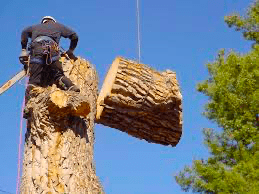What Happens After Your Removal Your Lansing Trees?

When an accident or any safety hazard has been associated with the tree, whether it has caught a disease, due to its falling fruit, or it is now in the state of death, the best option to do is to cut it down. This may be a hard decision for some homeowners, but to avoid further peril or danger, they are left with no choice but to have it removed instead.
Once a tree is cut down, its trunk is broken off and carried away as mulch, chopped into smaller logs or blocks for other purposes, while its roots remain on the ground. Since it is chipped down into smaller pieces known as the mulch, it is now used as a layer for the surface of the soil. Mostly, the reason for it may include preserving the moisture of the soil, improving soil’s fertility and health as it also reduces weed growth, and of course, helps in enhancing the visual appeal of a landscape. Chopped logs or blocks are often turned into other projects like chairs or coffee tables, which serve as a souvenir from the tree.
Related: Benefits of Getting Your Lansing Mi Trees Removed
Since the tree was cut, it cannot produce or create food for its roots if it does not have leaves. However, the roots may still absorb and have enough nutrients to support the growth of sprouts from the roots or the stump. A sprout can eventually grow into a tree if it produces enough leaves, however, if the tree fails to produce any sprouts, the tree will not regrow and the roots, on the other hand, will eventually decay.
Why should it be removed?
Once the tree is cut, homeowners are left with the decision to either or not remove the stump.
Tree trunks can be extremely dangerous.
Stumps protruding from the ground can injure someone who is running around in a backyard, especially children. Also, yard work becomes more difficult since the area around the stump should be maintained. The tree stump and root area should be avoided during mowing of grass, which adds hassle to homeowners. Failure to do so may risk damaging a lawnmower in instances it was run over.
Tree stumps allow access to pests and insects.
Tree stumps are also living organisms that can house a variety of pests and insects. During the lengthy decay process, stumps attract insects like ants, termites, and beetles. If not controlled effectively, these pests can spread to other plants in a landscape or even access inside a home.
Tree stumps might detract from a home’s appearance.
Tree stumps strewn throughout a well-kept lawn often stand out and catch the eye and detract from the beauty of one’s surroundings. The land’s aesthetic, in turn, has an impact on its real-estate worth. A significant number of tree stumps may reduce the value of a home. Aside from that, tree stumps take up a lot of valuable yard area and this space might be transformed into an outside porch or a gathering spot for family picnics instead of a spot taken by such a stump.
What to do after removal?
After the removal of the tree stump, the space where the stump was located should be cleared away with all the debris to be appealing as other space around it. Once the area is all clean and cleared out with all the debris, start adding soil for preparation as an area for replanting. The area can now be used as the same space to plant another tree as long as the soil is nourished and healthy to sustain another growing tree. On the other hand, it can also be a space for a patio or area to grow plants.
Contact A Professional Arborist
To guide homeowners for proper decision-making for the removal of trees and to provide them with what to do after the removal of a tree, it is recommended to consult and seek professional help from the experts. Lansing Tree Services is equipped with a set of skills, expertise, and knowledge to provide quality service with all things related to tree removal.